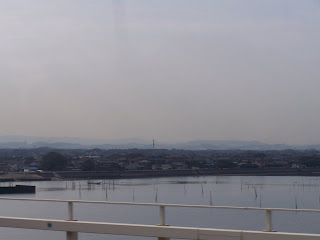
Next train line on my treck across Chiba was the Isumi line, another small one-car collector's train line.

And for some, as yet unexplained, reason, this line runs under the sign of Moomins.


The Moomin headquarters are at Kuniyoshi, but along the whole train line it is possibe to see small Moomin houses and characters, fishing at the side of small streams, of sitting around camp fires.



As that was where my hotel was, I took the opportunity to wander around Kuniyoshi a bit. It is a small city, largely based on rice production,

A self service rice-cleaning booth.
but with some ongoing road constructions and house expansions.


I was instructed, at Kuniyoshi station, that they were having a summer festival in Ootaki, a village on the opposite side of where I had planned to go. But when the small one-car train bound for Ootaki arrived, packed full of people like a morning train in Tokyo, I decided to stick to my plans and head on to Oohara, to see the beach!

Oohara is a very old-style japanese city, without any high-rise buildings, based largely on fishing.

There are 2 very nice temples in the city itself, one a rather common wood and plaster construction.

The second, a beautiful wooden, thatched-rooved temple was build on the side of a small hill overlooking a small lake. The lake, filled with water lilies and what might have been redhead ducks also had a small little red wooden bridge across to another small temple building.

Climbing up the hill behind the temple, one could see the famous Oohara temple bell, taken to the United States after the wall, but kindly returned to them by Duluth some years later. This is really just trivia, as the bell was of quite ordinary size and disposition.


Although I've seen from the maps that the northern shore of Oohara is a wide beach, famous for surfing and such, the southern coast is lined with sheer limestone cliffs, interspersed with small coves. On the last cliff before the city port, a small shrine has been built, to protect those going off to sea. They had a large anchor in lieu of statues near the shrine, and many small recesses filled with fox statuettes, a diety known for cunning and mischief.

As I got my first good look at the Pacific Ocean, these protections seemed rfectly in order, as it could only be described as brooding. The sky was a dark grey, low over the water, and the waves were quite high, clearly delimitating the 'inside' and 'outside' of the port breakwater.

I had time to tour the little hill on which the shrine was built before the rain hit, and then just waited it out, as were the fishermen on the wharves. 'cue for promoting how great my new raincoat is'

Although it never actually stopped raining, it did settle down into an acceptable drizzle, Turning the cliffs into a mozaic of sun and shade.

Oohara is still about 2 hours from Tokyo, and another hour and a half home to Oppama, so I did not feel I had the time to explore further along the southern shore of Oohara, much to my regret. That will definitely be on my list of further trips, though, as it seemed an absolutely beautiful place to go walking. Preferably not in the rain, of course.















































